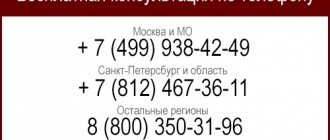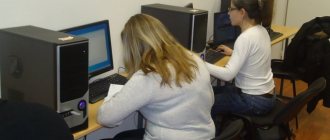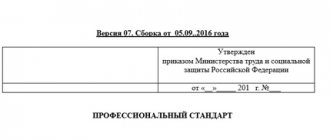Author of the article: Vladimir Danilevsky Last modified: January 2020 1114
The current legislation clearly defines the requirements for workplaces of employees of organizations performing work within the framework of job regulations. Any deviation from labor law norms is strictly punishable. At the same time, the employer himself should be interested in observing temperature standards in the workplace, because the productivity of the subordinate and the final result of his activities directly depend on this. The main document establishing the requirements for the microclimate in the premises of organizations is SanPiN. What you need to know about the latest act, and what liability a negligent manager faces in case of violations will be discussed in the article.
What you need to know
Speaking about the temperature regime in the workplace and measures to optimize personnel work in winter and summer, we remember about the decree of the Chief Sanitary Doctor of Russia dated June 21, 2016 No. 81 “On approval of SanPiN 2.2.4.3359-16 Sanitary and epidemiological requirements for physical factors in the workplace” ( together with SanPiN 2.2.4.3359-16. Sanitary and epidemiological rules and regulations...).
This resolution was registered with the Ministry of Justice on August 8, 2016 under No. 43153 and has the status of a valid regulatory document that is binding. The inevitability of the resolution is achieved not only by registration with the Ministry of Justice, but also by a direct indication in paragraph 1.2 of the SanPiN itself, which states that compliance with the requirements of the rules is mandatory both for citizens who are in labor relations and for individual entrepreneurs and legal entities. Literally, this means that failure to comply with sanitary requirements, including refusal to change working conditions if the temperature regime according to SanPiN does not correspond to optimal indicators, is grounds for imposing a fine under Article 5.27.1 of the Code of Administrative Offenses of the Russian Federation - up to 80,000 rubles.
Next, let's take a closer look at the sanitary requirements and tell you how to navigate the temperature and what to do in each case.
What requirements are established by SanPiN?
According to Art. 21 of the Labor Code of the Russian Federation, employers are obliged to create the most comfortable conditions in the workplace for their subordinates. First of all, special attention is paid to the safety of people. Also, considerable attention is paid to the microclimate. The fact is that spending most of the time in a stuffy room, a person can acquire many diseases that will become chronic over time. Thus, legislation requires maintaining a certain temperature, humidity and other parameters in production and in the office.
Article 21 of the Labor Code of the Russian Federation
“Basic rights and responsibilities of an employee” (more details)
Standard indicators are established taking into account the nature of the employees’ work. So, if workers are constantly moving, then their places are heated less. The situation is different with sedentary activity.
According to SanPiN, the established temperature regime at the place of performance of official duties in the summer should correspond to 23-25 degrees with a humidity of no higher than 60 and no lower than 40 percent. Warming up of surfaces should not go beyond the range of 22-26 degrees, the air flow speed should not exceed 0.1-0.3 m/s.
In winter, classrooms must be heated to 22-24 degrees. The remaining indicators correspond to the above figures. The optimal temperature is considered to be 21-25 degrees Celsius.
Next, you should refer to the table containing summary information about the standard temperature conditions in the workplace:
| Degree of staff activity | Warm w/g, °C | Cold w/g, °C |
| Minimum | 22-25 | 21-24 |
| Slight (walking) | 20-22 | 19-21 |
| High | 19-21 | 17-19 |
| Constant | 18-20 | 16-18 |
Expert commentary
Kamensky Yuri
Lawyer
Thus, in order to avoid being held liable, the employer must take into account SanPiN 2.2.4.548-96. The act clearly regulates the requirements for the conditions in which persons employed in production (in offices) must work.
Permissible temperature rise in summer
If the temperature in the office is not maintained by more than 2°C, then performing duties becomes much more difficult. The tenant can get out of the situation by installing an air conditioner. If for some reason the manager does not meet the employee halfway, then the latter should not endure increased stress on the body. Deviation from the norms allows employees to exercise their right to a shorter working day.
Depending on the room temperature, the working period is shortened as follows:
- 29°C – for 2 hours (no more than 6 hours);
- 30°C – for 3 hours;
- for each degree above 30°C – for 1 hour;
- 32.5°C – you can only work for 1 hour at work.
Some employees are skeptical about management's initiative to equip the premises with air conditioning. The fact is that this device can have a negative impact on human health, comparable to heat. Therefore, the requirements of SanPiN, in addition to temperature and humidity, limit the speed of air flow in the room where employees are working. The maximum permissible value is 0.3 m/s. Thus, subordinates should not be exposed to air flow from the air conditioner. When installing the device, this fact must be taken into account.
How does the length of the working day change if the room is cold?
This problem is especially relevant for office workers. Their sedentary nature of activity does not allow them to warm up in a cold room. Because of this, employee productivity decreases. A decrease in temperature to 15 degrees is allowed only if a person performs tasks related to physical activity. As noted earlier, the optimal mode that meets the requirements of established standards is to warm up offices to 21-24°C. In this case, the maximum permissible deviations should not exceed 2°C. If the temperature difference is short-term, then a jump range of 4°C is allowed.
Expert commentary
Leonov Victor
Lawyer
A full day of work is allowed if the air temperature is maintained at 20 degrees. If this value is not achieved, then the time to attract employees is reduced.
The duration of performance of official duties in this case will be as follows:
- 19°C – seven-hour working day;
- 18°C – 6 hours and so on;
- at a temperature of 13°C, office workers can perform their duties for only 1 hour (if the activity is sedentary).
A few words about SanPiN
Considering that the Labor Code mentions the temperature regime in passing, SanPiN stipulates in detail all the important points. This is a lengthy document, but understandable even for a non-specialist. Contains several sections that include requirements for jobs by level:
- noise;
- vibrations;
- infra- and ultrasound;
- electric and other fields;
- laser and ultraviolet radiation;
- on the microclimate in production premises.
As for noise, vibration and radiation, as life shows, people are not as concerned about this as the temperature in the work room or outside, when it is above 30 degrees. Under such conditions, workers’ bodies begin to experience serious stress, and this is no joke. At what ambient temperature does stress begin according to the law, is written in SanPiN.
SanPin requirements for production premises
Certain SanPiN requirements have been established for production premises or offices. If the temperature in a workplace (the standards are officially enshrined in laws) deviates from acceptable parameters, the manager, according to the rules, must limit the time an official spends at the workplace or take care of improving conditions.
SanPin
For example, an eight-hour standard working day is maintained only under conditions where the room temperature is no more than 28°C and no less than 20°C. Extra or missing degrees reduce the working day by 1 hour.
For this reason, special thermometers must be installed in each production or office premises at a height of approximately 1 m from the floor in order to monitor compliance with working conditions established at the official level. If the conditions do not meet the requirements, the employee must receive work with additional pay at an industrial establishment.
How it works
SanPiN 2.2.4.3359-16 does not apply to divers and cosmonauts, to the conditions for performing emergency rescue operations or combat missions (by whom, it is not specified, but obviously we are talking about rescuers and firefighters).
Further, SanPiN 2.2.4.3359-16 indicates that it imposes requirements for workplaces. SanPiN does not explain what workplaces are, but in paragraph 2.1.2 it indicates that hygienic requirements for microclimate indicators are established for workplaces in production premises. This means that the temperature regime for working on the street is not formally regulated by SanPiN, and it does not formally apply to those who have to work in the heat in the open air, for example, to road workers (it does, of course, but what to do if it says so) .
Now about the production environment and microclimate.
There are five microclimate indicators:
- air temperature;
- surface temperature;
- relative humidity;
- air (wind) speed;
- intensity of thermal radiation.
Taken together, they represent a comfortable environment in which working conditions are optimal.
What is not included in these indicators, but is taken into account by SanPiN, is the clothing in which a person works. It is hot to work in cloth, and sometimes uncomfortable overalls discourage workers from working. Let's look at the special rules. For a unit of clothing, SanPiN takes a set of items with thermal insulation of 1 CLO in the cold season and 0.7-0.8 CLO in the warm season for an 8-hour work shift.
CLO is a unit of measurement for the insulation properties of clothing. To immediately avoid questions like “how much CLO is in regular jeans or a T-shirt,” let’s say that this is a relative value. 1 CLO is the amount of clothing you need to feel comfortable. For example, the normal temperature in a room at work at a computer, when a person is just sitting, is +25. But if you stand up and swing a sledgehammer 30 times, the temperature will seem comfortable up to +10. What is important to understand here is that clothes retain heat, but do not produce it. If clothing is heated, it will also warm the worker (if it is not special clothing). If the worker himself is heated, then his clothes retain heat and cause overheating of the worker himself. CLO does not affect the physical performance of the workplace, but it does affect the person and therefore must be taken into account.
Optimal values of microclimate parameters
What are the categories of work by energy consumption? This is an indicator of the release and loss of human energy during work (includes the metabolic rate from background metabolism to the mechanical power developed by the muscles). For example, work of category Ia is sedentary work with little physical stress, and work of category III is associated with constant movement with a load, for example, with a sledgehammer.
Professions by job category
| Ia | Mostly sitting work: personnel, accounting, seamstresses, watchmakers, typesetters, proofreaders, etc. |
| Ib | Work performed both sitting and moving: librarians, various types of controllers, including in transport, etc. |
| IIa | Work that involves constant walking: pizza delivery people, couriers (the weight of the delivered cargo does not exceed a couple of kilograms), etc. |
| IIb | Work related to moving weights up to 10 kilograms: loaders, mechanics, etc. |
| III | Work associated with moving weights over 10 kilograms or requiring constant physical effort: foundry workers, etc. |
Knowing which energy consumption category your professional activity falls into, you can easily determine the optimal values for your microclimate.
But what to do if these values deviate greatly from normal values? For this purpose, there are special tables that establish work rules if the temperature standard in the workplace does not correspond to optimal values.
Indoor air temperature and humidity parameters:
During the cold season in living rooms, the optimal temperature is 20-22 degrees, and the optimal humidity is 30-45%.
Similar figures are given in SNiP 2.04.05-91* “Heating, ventilation and air conditioning”, Appendix 5 as mandatory, cold (winter) and transitional (spring and autumn) periods - optimal humidity 30-45%.
The same figures are given in SanPiN 2.1.2.1002-00 “Sanitary and epidemiological requirements for residential buildings and premises.”
Normal humidity in residential premises is defined in SanPiN 2.1.2.1002-00. "Requirements for residential buildings and premises." Normal humidity in a room where there is no forced ventilation system is maintained through regular ventilation.
In accordance with “SNiP 23-01-99* “Building Climatology”, the following room modes are distinguished by humidity levels: dry (less than 40%), normal (40÷50%), humid (50÷60%) or wet (over 60%).
According to GOST 30494-2011 “Residential and public buildings. Indoor microclimate parameters”, air humidity in residential premises is not allowed to exceed 60% (the optimal humidity value is no more than 45%).
New standards SNiP 23-02-03 “THERMAL PROTECTION OF BUILDINGS” have determined the design parameters of the relative humidity of premises to determine the dew point and temperature requirements on the inner surface of windows:
5.9 ... The relative humidity of internal air to determine the dew point temperature in places of heat-conducting inclusions of enclosing structures, in corners and window slopes, as well as skylights, should be taken:
- for premises of residential buildings, hospitals, dispensaries, outpatient clinics, maternity hospitals, boarding homes for the elderly and disabled, comprehensive children's schools, kindergartens, nurseries, kindergartens (plants) and orphanages - 55%, for premises kitchens - 60%, for bathrooms - 65%, for warm basements and underground areas with communications - 75%;
- for warm attics of residential buildings - 55%;
- for premises of public buildings (except for the above) - 50%.
5.10... The temperature of the inner surface of the structural elements of the glazing of windows of buildings (except for industrial ones) must be not lower than plus 3 ° C, and of opaque window elements - not lower than the dew point temperature at the design temperature of the outside air in the cold season, for industrial buildings - not lower than zero ° C.
Microclimate tables
Permissible duration of stay at workplaces at air temperatures above permissible values
Permissible duration of stay at workplaces at air temperatures below permissible values
Working hours in the office depending on air temperature
These tables are what you need to focus on.
The importance of office climate
Temperature conditions greatly influence the well-being and performance of people. Increased or decreased air temperature, which affects an employee for a long time, not only has a negative impact on health, but also sharply reduces labor productivity. Office employees perform a wide variety of activities, most of which involve spending a long time in the same position, usually sitting and sedentary:
- work at a computer;
- draw up paperwork;
- communicate with clients;
- make decisions, etc.
Mental work and physical inactivity do not go well with an uncomfortable room temperature. Researchers have experimentally found that deviations even within one degree have such a strong impact on the efficiency of office work that it makes sense to even shorten the working day if it is impossible to provide the proper microclimate.
Ensuring proper temperature conditions in the office is a legal obligation of the employer, regardless of the form of ownership and level of subordination of the organization.
How to navigate the temperature
Working in hot weather or in cold weather means special working conditions. They impose certain responsibilities on employers.
Those working in the fresh air at an air temperature of +32.5 ° C are entitled to cool rest every 20-30 minutes. The break for such a rest lasts at least 10-15 minutes. Based on the recommendations of Rospotrebnadzor, at what temperature you can work, working outside at + 37 ° C and above is not allowed. At the same time, there is a rule that minors and people over 40 years old, pregnant employees and people suffering from chronic diseases are not involved in working in the heat.
If the room is +30 degrees, then we look at what jobs we work on and determine the length of the working day. Air speed and relative humidity are not of concern to us. There are, of course, in SanPiN maximum indicators (as they should be) for humidity and speed of movement of air masses (see paragraph 2.2.7), but tables of working hours are calculated exclusively based on degrees of air temperature. Therefore, we look at the thermometer, look at the table, find the required column and get the result: how long you need to work at this temperature.
But what should a boss do if workers have to work in hot conditions and the production process cannot be stopped? The employer's responsibilities in hot weather are to provide workers with comfortable working conditions. At least buy a fan. The best option is to purchase a split system that maintains a comfortable temperature in the room. But this is not a panacea either. Even a large air conditioner outside the window does not always help. Also, ideally, you need a humidifier. Yes, it's expensive, but it's worth it.
At a minimum, employees see that their employer loves and appreciates them. In addition, employee stress is reduced, which means fewer errors in work.
As a maximum, you won’t have to write an explanation to the State Tax Inspectorate or the Investigative Committee if someone ends up in the hospital due to the heat.
Seasonal requirements for office temperature
In cold and warm seasons, ensuring optimal temperature is achieved in different ways. Accordingly, the requirements for the microclimate will differ, as well as the measures provided for by SanPiN in the event of the impossibility of ensuring the temperature regime or its serious violations.
So that it doesn't get too hot
Prolonged exposure to elevated temperatures is particularly detrimental to the performance and health of workers. In a closed work space, it can be aggravated by large crowds of people, the presence of working office equipment, and compliance with a special dress code.
In this regard, the optimal temperature values and the permissible maximum during the hot period of the year are legally established. For office workers they are 23-25°C with a relative humidity of 40-60%. Temperature increases up to 28°C are allowed.
Exceeding summer temperatures in the office
If the thermometer inside the office deviates from the optimum by more than 2°C, it becomes much more difficult to work. The employer will have to supply air conditioning for employees and ensure its normal operation and timely maintenance.
If for some reason this is not done, the employee should not meekly endure the sweltering heat, while also trying to meet professional requirements. Sanitary standards allow workers to rightfully shorten the standard eight-hour working day, for which the temperature requirements are designed:
- 29°C allows you to work 6 hours instead of 8;
- 30°C allows for a two-hour contraction;
- each subsequent degree exceeding the norm reduces the working time requirements by another 1 hour;
- if the thermometer reaches 32.5°C, you don’t have to stay at work for more than 1 hour.
Many employees note the negative impact of air conditioning, comparable in harm to heat and stuffiness. The same requirements of SanPiN, along with temperature and humidity, limit the speed of air movement in the room, which should not go beyond the range of 0.1-0.3 m/s. It follows that the employee should not be under the blowing air conditioner.
What does GIT say about this?
GIT specialists, commenting on what temperature should be in the workplace and what to do in case of deviations, explain: if there is not enough money to create comfortable conditions (purchase of the same fans and heaters), it is permissible to introduce downtime for reasons beyond the control of the employer , and the employee. Another option is for the administration to transfer employees to work from home during abnormal temperatures, extend their rest and meal breaks, or completely change the staff’s work schedule. True, for such forced innovations, the employer will have to enter into additional agreements to employment contracts. The editors of ClubTK believe that it is more convenient to introduce these provisions into the PVTR and, when certain circumstances occur, simply issue an order.
As for working in the cold, there are certain general rules. Thus, in accordance with Article 109 of the Labor Code of the Russian Federation, some categories of workers need to establish additional breaks for heating and rest, and this time is included in working hours. Rostrud reminds that only those citizens who do not have any medical contraindications for working in the cold are allowed to work in the cold. And without fail, workers are given personal protective equipment “depending on the weather.”
Speaking about special breaks for heating, officials remind that their number and duration are established by acts of the employer, and they depend not only on the air temperature, but also on the strength of the wind. One of the organization’s responsibilities is to ensure a temperature of 21-25 degrees in heating areas and install special equipment that maintains a temperature of 35-40 degrees to warm hands and feet.
Rostrud reminds that the employer is obliged to provide subordinates with normal working conditions and is liable, even criminally, for inaction and causing harm to the health of the employee. To avoid this, officials propose to study and begin to implement the methodological recommendations of the Chief State Sanitary Doctor “Work and rest regimes for workers in cold weather in open areas or in unheated premises” (MP 2.2.7.2129-06).
Minimum room temperature according to the Labor Code
According to the requirements of the Labor Code of the Russian Federation, the temperature in the office, according to sanitary standards, in winter should not fall below 20 ° C (minimum). If the standards have been violated, the employer is obliged to install an additional heater or reduce the number of working hours per week.
Lighting standards for an office workplace
In the Labor Code of the Russian Federation there are certain temporary norms (normal conditions), or rather their reductions when the room temperature is too low:
- 19 °C - 7-hour working day;
- 18 °C - the employee must be released after 6 hours in the office;
- 17 °C - 5 hours;
- 16 - 4 hours;
- 15 - 4 hours;
- 14 - 2 hours
For your information! Experts studying working conditions have found that a person is strictly prohibited from working at an ambient temperature below 13°C, since this is dangerous for the body. Vital functions of the body will be disrupted.
If the room temperature is low, the employee will get sick
Temperature in the office
Currently, in a number of regions of the Russian Federation, including Moscow, there is an emergency situation associated with extremely high air temperatures, as well as heavy smoke due to forest fires.
The combination of these factors has an extremely adverse effect on the health of working citizens.
In accordance with Article 212 of the Labor Code of the Russian Federation, the employer is obliged to provide safe and healthy working conditions for employees.
Time spent at workplaces at air temperatures above permissible values
| Air temperature at the workplace, °C | Stay time, no more for categories of work, hours | ||
| Ia - Ib (work performed sitting or standing with minor physical exertion) | IIa - IIb (work associated with constant movement (walking), moderate physical activity, carrying and moving weights up to 10 kg) | III (work associated with constant movement (walking), significant physical activity, carrying and moving heavy objects over 10 kg) | |
| 32,5 | 1 | — | — |
| 32,0 | 2 | — | — |
| 31,5 | 2,5 | 1 | — |
| 31,0 | 3 | 2 | — |
| 30,5 | 4 | 2,5 | 1 |
| 30,0 | 5 | 3 | 2 |
| 29,5 | 5,5 | 4 | 2,5 |
| 29,0 | 6 | 5 | 3 |
| 28,5 | 7 | 5,5 | 4 |
| 28,0 | 8 | 6 | 5 |
| 27,5 | 8 | 7 | 5,5 |
| 27,0 | 8 | 8 | 6 |
| 26,5 | 8 | 8 | 7 |
| 26,0 | 8 | 8 | 8 |
In addition, in order to prevent the adverse effects of these factors, the employer can use protective measures (local air conditioning systems, air showers, personal protective equipment - in particular, wet gauze dressings and respirators, rest rooms, regulation of work hours, in particular, breaks work, etc.).
In the event of a reduction in the duration of daily work (shift), remuneration of workers for the time for which working hours are reduced may be made in accordance with Part 2 of Article 157 of the Labor Code of the Russian Federation as downtime for reasons beyond the control of the employer and employee, in the amount of not less than two-thirds of the tariff rate (salary, official salary), calculated in proportion to downtime.
In addition, it may be recommended, taking into account weather service forecasts, to provide, by agreement between the employer and the employee, short-term annual paid holidays outside the schedule.
The impact of a heating microclimate has a harmful effect on the working body, contributing to a deterioration in well-being, decreased performance and poor health.
The hot weather that has established over most of the territory of the Russian Federation, in which the air temperature exceeds the long-term average values for a given period of the year, leads to a deterioration in working conditions for workers in open areas, in industrial and public premises without air conditioning.
Work in a heating microclimate must be carried out in compliance with the measures to prevent overheating and the recommendations regarding the operating mode set out in the leaflet.
Reminder for workers in conditions of high air temperature.
- To prevent overheating of the body (hyperthermia), it is necessary to organize a rational operating mode. When working outdoors and outdoor temperatures of 35 °C and above, the duration of periods of continuous work should be 15 - 20 minutes, followed by a rest period of at least 10 - 12 minutes in refrigerated rooms. In this case, the permissible total duration of thermal load per work shift should not exceed 4 - 5 hours for persons using special clothing to protect against thermal radiation and 1.5 - 2 hours for persons without special clothing.
- In a room in which the normalization of a person’s thermal state is carried out after working in a heating environment, the air temperature, in order to avoid cooling the body due to a large temperature difference (body surface - ambient air) and increased heat transfer by evaporation of sweat, should be maintained at 24 - 25 ° C.
- Working at an outside air temperature of more than 37 °C is classified as dangerous (extreme) based on microclimate indicators. It is not recommended to work outdoors at temperatures above 37 °C. The workday routine should be changed, moving such work to the morning or evening.
- To protect against excessive thermal radiation, it is necessary to use special clothing or clothing made of dense fabrics. It is recommended that persons no younger than 25 and no older than 40 years old be allowed to perform such work.
- In order to prevent dehydration, it is recommended to properly organize and maintain a drinking regime. Drinking water must be in sufficient quantity and within easy reach. Recommended temperature of drinking water, drinks, tea is 10 - 15 °C. For optimal water supply, it is also recommended to compensate for the loss of salts and microelements excreted from the body through sweat, providing for the provision of salted water, alkaline mineral water, lactic acid drinks (skimmed milk, whey), juices, fortified drinks, oxygen-protein cocktails.
- You should drink water often and little by little to maintain good hydration of the body (optimal water content in the body, which ensures its normal functioning and metabolism). When the temperature is above 30 °C and you are doing moderate work, you need to drink at least 0.5 liters of water per hour - approximately one cup every 20 minutes.
- To maintain immunity and reduce intoxication of the body, it is recommended, if possible, to consume fruits and vegetables
Maintaining normal temperature is an important condition for the normal functioning of the company. Not only the health of workers, but also their labor productivity, as well as the normal functioning of the entire enterprise, depends on the temperature in the office.
Temperature standards are regulated by SanPin 2.2.4 548 96. The fifth and sixth sections of the Rules are devoted to optimization and temperature limits depending on the season (warm or cold).
Office workers whose work can be classified as intellectual, characterized by a low level of physical activity, as well as a sedentary position, are included in category Ia by the Labor Code and SanPin. For this category of employees, a temperature of twenty-three to twenty-five degrees (in summer) and twenty-two to twenty-four degrees (in winter) must be provided.
If the room temperature does not meet the specified standards, employees have the right to demand that the employer reduce the duration of work shifts.
If the temperature exceeds plus twenty-nine, labor time is reduced to three to six hours (in accordance with the functions performed). If the temperature in the office exceeds thirty-two degrees, working for more than one hour is prohibited.
There are indicators for the cold season. At temperatures below nineteen degrees, the shift duration is reduced by an hour. At temperatures below thirteen degrees Celsius, the working day cannot exceed one hour.
The work of an organization whose management constantly violates the temperature conditions of the premises can be temporarily stopped for a period of up to three months.
According to the Labor Code, the room temperature in the summer should not be higher than:
- 28 degrees Celsius for 8 hours of operation.
- 30 degrees Celsius for 5 hours of operation.
- 31 degrees Celsius for 3 hours of operation.
- 32 degrees Celsius for 2 hours of operation.
- 32.5 degrees Celsius for 1 hour of operation.
Working at temperatures exceeding 32.5 degrees is considered dangerous. The employer has several ways to avoid the heat, namely: install special equipment (air conditioners, fans) in the work premises or reduce the number of working hours by special order.
Salaried workers often face negligence from their employers. What to do in this case? There are several options:
- ask the employer to normalize the temperature using equipment (air conditioning, heater)
- demand a reduction in hours of work in accordance with regulations
- file a complaint with Rospotrebnadzor
- contact the labor inspectorate for help
In the last two options, a special inspection will be carried out at the place of work, during which it will be determined whether an offense has been committed.
Failure to comply with temperature conditions
In accordance with the Code of Administrative Offenses, an employer who violates sanitary standards will be fined up to 20 thousand rubles, or its activities will be suspended for a certain period.
It is worth noting that violations of the correct temperature can only be detected by a special service, the SES. As a result, any legal entity that violates the norms of the Labor Code of the Russian Federation will be subject to punishment.
Based on all of the above, we can conclude that the employer must control the correct temperature in the room for 8 hours of work: no higher than 28 degrees Celsius in the summer, no lower than 20 degrees Celsius in the winter.
The microclimate of industrial premises is an important condition for normal work; not only well-being and health, but also the performance of employees and their functional state depend on it. SanPiN 2.2.4.548-96 establishes normal microclimate parameters for any industrial premises and workplaces. And in its sections 5 and 6, its optimal and permissible values for different times of the year – the hottest and the coldest – are separately specified.
Those workers who work in office premises, the performance of work duties of which is characterized by minor physical effort and a sitting position, are classified by SanPiN as category Ia. For this category of workers, a comfortable temperature in summer is 23-25°C, and in winter – 22-24°C. In cases where these standards are not met, office workers have the right to demand a reduction in working hours.
What are the consequences of non-compliance with the rules and regulations?
Many employers are confident that it is not at all necessary to take care of the arrangement of their employees’ workplaces, much less create an optimal microclimate. Management's misconception is that if any employee decides to express dissatisfaction with working conditions, citing non-compliance with his own rights, then his objections can simply be ignored. Never forget that employees are a full-fledged workforce, which is endowed not only with job responsibilities, but also with corresponding rights.
Believe me, the right to work with optimal room temperature is just as important as, for example, the right to regular wages. Today, some directors give ultimatums like: “If something doesn’t suit you, then no one is holding you, quit. If you don’t want to lose your job, work.” It is worth noting that it is important for managers to constantly support their employees in a state of fear and fear of losing their jobs, but on the issue of working conditions, the current legislation fully supports both the side of the owner of a private company/head of a government organization and the side of hired employees.
Article 163 of the Labor Code of the Russian Federation stipulates the following: Any employer is obliged to take care of creating working conditions in the workplace that comply with the standards and requirements of sanitary documentation to ensure the productivity of hired employees. Thus, if the temperature regime at your workplace is neglected and management refuses to change anything, then you have the right to refuse to perform your duties until an optimal microclimate is created. In addition, it is worth noting that today the law establishes that the temperature in the residential premises of apartment buildings must also correspond to the data indicated by the sanitary-epidemiological and housing service of Russia.
If your request is constantly ignored or not taken into account, you can write a complaint to the state sanitary and epidemiological service, which will send an unscheduled inspection to your place of work. If during its course a violation is identified and recorded, your employer will be obliged to pay a fine in the amount specified by law. In the event that this does not bring the desired result and a refusal to comply with the rules and regulations is detected again, the activity of the enterprise will be suspended for a period of up to 3 calendar months to clarify the circumstances and correct the situation.
That is why the advice to all employers is not to try to ignore the established standards regarding room temperature, because this can be fraught not only with a drop in the level of productivity of your employees, but also with protracted proceedings, monetary losses and other unpleasant phenomena provided for by current laws regarding this issue. We have just looked at what temperature should be maintained in the office premises and what responsibility is provided for those managers who are in no hurry to think about the convenience of work for their employees. If you have suspicions that your rights are being violated, do not try to come to terms with this fact, but fight for your rights.
Standard according to SanPiN
Few people know, but certain criteria are prescribed at the legislative level, thanks to which labor protection is carried out. We are talking about sanitary rules and regulations - SanPiN, a code of standards that define, according to the name, hygienic and health standards for the employment of the population. Simply put, we are talking about working conditions in an office at unacceptable temperatures. If the premises are very cold or hot, then section 2.2.4.548-96 of SanPiN “Hygienic requirements for the microclimate of industrial premises” stipulates the permissible temperature limits in Celsius and the number of working hours.
All these restrictions are determined by the Labor Code of the Russian Federation, which requires the employer to strictly comply with the rules, based on Federal Law No. 52 “On the sanitary and epidemiological welfare of the population” of March 30, 1999. If the employer demands strict development of a plan, and you are still on the “brink of survival,” then, according to Article 163 of the Labor Code of the Russian Federation, he is obliged to take a set of measures to create comfortable or optimal conditions for employees. For example, install air conditioners or heaters.
Precedents of non-compliance with these laws are fined a round sum, and for special cases a measure is provided to stop the company’s activities for 3 months, according to Art. 6.3. Code of Administrative Offenses of the Russian Federation.
It's sad, isn't it? This is the price to pay for our comfortable and humane working conditions, since slavery was abolished a long time ago.
So, above we examined the legislative part in detail. What did it stipulate and what microclimate should be maintained in a modern office?
Temperature
The temperature regime according to SanPiN is set for each room. In the cold season, in the living room, a stable optimal temperature should be set within 20-22°C, acceptable - 18-24°C.
For the kitchen and toilet - 19-21°C, bathroom combined with a toilet - 24-26°C, in the corridor -18-20°C, lobby, pantry - 16-18°C. The permissible microclimate for the kitchen and toilet is 18-26°C, the bathroom combined with a toilet is 18-26°C, the corridor is −16-22°C, the pantry is 12-22°C.
During the warm season, the optimal temperature in the apartment should be in the range of 22-25°C.
Acceptable conditions are within 20-28°C. With centralized heating, the easiest way to check whether the heating network complies with heat transfer standards is to measure the temperature of the tap water in a thermal glass.
To fully check compliance with the temperature standards in the apartment, you need to call the “Emergency Dispatch” service team. Based on the results of the inspection, an act is drawn up in two copies. One copy remains with the apartment owner, the second is transferred to the service organization.
If the standards are not met, the Managing Organization must recalculate the cost of the service for the corresponding period by 0.15%.
When setting the temperature in an apartment, it is necessary to take into account its location. An apartment located on the north side requires the warmest possible conditions, and for a child’s room, a few degrees higher on top of this. A south-facing room, without temperature adjustment, will require frequent ventilation.
IMPORTANT! You can independently regulate the temperature in your apartment by installing a modern radiator with the appropriate function.
Entrance
The temperature regime in the staircase is prescribed according to the Gosstroy standard and should be within 16-18°C.
Basement
Regulatory standards set the temperature for non-residential premises of a building, including the basement. According to the standards, in the basement it should not be lower than +5°C.
Floor
In regulatory documents, floor temperature is classified as surface temperature. Minimum permissible +25°С, maximum +31°С. Under normal conditions, the floor temperature depends on the atmosphere in the room, the level of heating of the lower room, and the thermal insulation of the floor.
When installing a “warm floor” system, it is necessary to take into account the characteristics of the floor covering and coordinate them with the temperature of the “warm floor”. Otherwise, due to overheating, the floor covering may be destroyed. The characteristics of the flooring material can be clarified with the seller when purchasing it.
The Management Company or Housing Office is responsible for compliance with temperature standards. Residents’ complaints can only be absent if preventive and repair work on the heating and hot water supply systems is carried out in a timely manner, and if there are no sources of heat loss in the building.
To resolve the issue of non-compliance with the heat supply to the apartment, you must contact service organizations. If they fail to act, contact the consumer rights protection authority.
What does the Labor Code of the Russian Federation say?
The Labor Code also pays attention to temperature in the workplace. In particular, in Art. 22, 163, 209, 212 of the Labor Code of the Russian Federation states that employers must create a comfortable environment in the workplace that complies with state labor protection standards (in offices, production workshops, etc.). It has been proven that in favorable conditions the performance of staff will be higher. If the temperature balance is violated, the employer must take the necessary measures to eliminate the violations.








